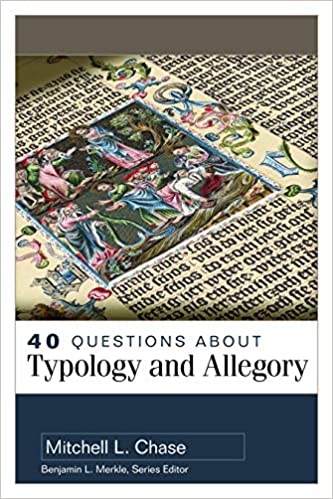A Book Review from Books At a Glance
By Mark Baker
Mitchell L. Chase (PhD, The Southern Baptist Theological Seminary) is the author of a commentary on Daniel in the ESV Expository Commentary series as well as The Gospel Is for Christians. This book is another installment in the excellent 40 Questions series edited by Benjamin Merkle.
Overall, Chase argues for a return to “pre-modern exegesis” spearheaded by a proper understanding of typology and allegory. Crucial to Chase’s argument are his definitions. Chase defines a “type” as “a person, office, place, institution, event, or thing in salvation history that anticipates, shares correspondences with, escalates toward, and resolves in its antitype” (38). Following O’Keefe and Reno, Chase asserts that “Allegory is more fluid and ambitious. It seeks patterns and establishes diverse links between Scripture and a range of intellectual, spiritual, and moral concerns” (197). Both typology and allegory are grounded in the literal sense of Scripture and do not necessarily deny the historicity of the original reference. Chase further argues that typology and allegory are not spectator sports. Christian readers of the Bible are free to engage in typological and allegorical interpretation of Scripture so long as they stay within four boundaries: (1) it needs to be rooted in the plain sense of the text; (2) it should not contradict other clear passages of Scripture; (3) it should honor the rule of faith; (4) it must honor the unity of the Old and New Testaments (252).
Roughly one-fourth of the book engages with the historical practice of typology and allegory. The historical overview is necessarily painted in broad strokes. Chase shows that the Church Fathers, medieval theologians, Reformers, and Puritans all encouraged typological and allegorical interpretation. Throughout church history, the only detractors of this kind of interpretation are those who deny the overall unity of the Bible (i.e. Enlightenment thinkers).
This book will challenge those who seek to interpret the Bible solely through the grammatical-historical method. The Great Tradition is full of examples of faithful Bible readers who engaged in edifying typological and allegorical readings without indulging in far-fetched interpretations.
Historical nuggets abound. To name a few: the Antiochene school actually did practice allegorical interpretation, and allegory often is closely tied to the literal sense of Scripture.
The few potential shortcomings of the book stem more from the restrictions of the series rather than from the book itself. I found myself searching for a more precise distinction between typology and allegory. For example, Rahab’s scarlet cord is mentioned as both typology (154) and allegory (262), and the descriptions between the two are not much different. Chase devotes two paragraphs to a mild defense of Origen’s method of allegory (209), which left me unconvinced of the helpfulness of the majority of Origen’s corpus. Perhaps an opportunity to develop a robust Christological reading of the Psalms was also missed.
These mild complaints aside, Chase has provided a wonderful resource in this book. It appears as if there is a growing movement that is celebrating “premodern exegesis” as a way for Bible readers to connect the head and heart. This book is now my go-to recommendation for those interested in the subject. It is relatively short and accessible, and the three-page select bibliography in the back will give the reader direction for going deeper.
Mark Baker (PhD, Southeastern Baptist Theological Seminary) is assistant director and professor at the Southwestern Baptist Theological Seminary Darrington campus in Houston, TX.
Copyright 2021, Books at a Glance
